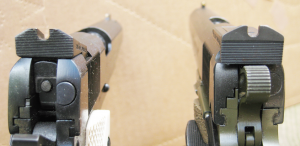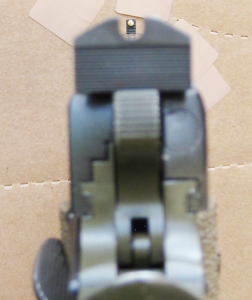by John Markwell Contributing Editor
If you’re considering some gifts for Father’s Day, a graduation or some important event like a birthday for a gunowner, you might not do better than to consider new sights, new magazines or a new holster or mag pouch.
These are gifts that might not come quickly to mind but that can improve a shooter’s enjoyment of and confidence in, their shooting. In many cases, new model guns may be just like the old editions except for new sights or other accessories.
So here are a few modest suggestions.
Sights To our knowledge, gold beads were the original high visibility front sights used on handguns and, as our eyes have gotten older, we have become very fond of them. In fact, we have gold bead front sights on quite a few handguns, both revolvers and autos. There are essentially two variations of the gold bead. The first is the Call gold bead as developed by Charles Call who was an S&W employee. The Call bead has a flat face. The McGivern gold bead, developed by exhibition shooter Ed McGivern, is generally somewhat smaller than the Call and has a rounded or convex face. Until recently, we hadn’t thought much about which rear sight we used in conjunction with a gold bead front but that all changed during the winter of 2012/13.
Several years ago we purchased a like-new 9mm 1911 CQB pistol that was built by Wilson Combat (wilsoncombat.com) for a friend of ours.
The gun was built on a Series 80 Colt and was to be used for shooting IDPA.
The only thing I didn’t like about the gun was that it had night sight inserts in both the front sight and the blade of the Wilson adjustable rear. I finally decided to get rid of the night sights and sent the pistol’s slide to Wilson’s with a note asking them to install a gold bead front sight and to replace the blade of the rear sight with one that was plain black. When the slide was returned we were astounded.
The gold bead that the boys at Wilson’s installed on the CQB’s slide was an impeccable McGivern bead but the real treat was the black Battlesight profiled rear blade they put on the rear sight. This rear sight blade tapers upward from the outer edges forming sort of a pyramid and it has a deep and wide sight notch with a rounded bottom.
The pyramid shape draws the eye to the front sight and obscures less of the target than flat topped blades like the old Bomar. We found the sight picture provided by this rear blade to be very fast to acquire and easy to hit with when used in conjunction with the gold bead front. In fact, we liked this set up so well that we got on the phone and ordered up one of Wilson’s Ultimate Speed Sights for our newly completed John Miller Colt 1911 in .45ACP, which already had a gold bead front. The Ultimate Speed Sight is a fixed sight, with the same pyramidal profile as the Battlesight, and it is designed to fit in the standard Novak sight dovetail.
Are these gold bead front and Wilson rear sight combos the final answer in 1911 sights? Probably not. But for this old practical shooter, the change to the Wilson rear sight profile has sharpened our sight picture (or at least made it all more easily visible), and has made it quicker to acquire that bright gold bead front. New technology has given us back some of the speed we’ve lost due to the aging process. We truly have been shooting better with these new sights and that’s what it is all about. If aging eyes are giving you trouble, you might want to look at these sights from Wilson Combat and, even if you have 20/20 vision, you could quite probably find some benefit in using them. I know that several shooters of my acquaintance have been wowed by them.
Magazines As we all know the heart of any autoloading pistol is its magazine. The greatest pistols in the world will not run with sub-standard, ill-fitting, or damaged magazines. In the 1911 world, there are lots of aftermarket magazines available and for many years those made by Wilson Combat have set the standard for ruggedness and reliability.
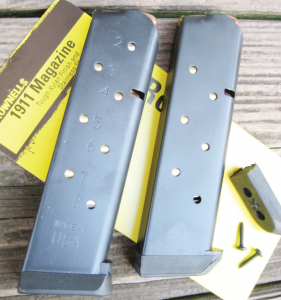
Brownells .45 ACP 1911 magazines; 8-rounder with removable base pad (left), 7-round mag with screw on base pad (right)
With such a crowded market that is dominated by one major player, we found it surprising that the folks at Brownells (brownells.com) were introducing a pair of proprietary 1911 magazines. Recently, we have been wringing out six of these new Brownells 1911 .45ACP magazines: two of the seven-rounders and four eight round models.
The first thing we noticed when we unpackaged these magazines was how slick they are. These magazines have bodies of heat treated stainless steel.
They have a black coating of Xylan (whatever that is) that is truly slick.
This reduces friction and provides for corrosion resistance. In fact, this coating is so slick we had the first mag we handled almost shoot out of our hands. The seven-round Brownells mags have traditional welded-on floor plates that have two pre-drilled holes for screw on rubber base pads which are also available from Brownells (part #620-000-011). The eight-round mags feature removable polymer base pads.
Both the 7- and 8-round magazines have witness holes for round counting, although only the eight-rounders are numbered. The mags’ followers are heat treated stainless and anti-tilt by design.
Their rounded top profile, in conjunction with an extra power spring, should ensure reliable last round feeding.
We have not had these new Brownells magazines in service for a very long time yet. Since acquiring them, they have been our “go to” mags when taking a .45ACP to the range. Our testing of any new 1911 magazines begins by checking them for fit by popping them in and out of a number of pistols to see if they securely lock in place and eject easily. Then we want to see if they will automatically lock the slides back when they are hand cycled. During our first shooting session we placed one round in each of the mags to see if they will reliably feed a last round and lock the slide back upon going empty. Lastly, we top the mags up and insert them in the pistol’s mag well (with the slide in battery) to ensure they will lock in place without undue force. The new Brownells 1911 magazines passed these tests with flying colors and we have been using them ever since.
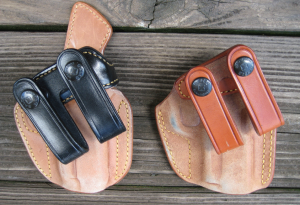
Older version of the Galco Royal Guard IWB holster (right) and the new version with the sweat guard (left)
So far we have had no issues with these newly introduced magazines from Brownells. However, as most TGM readers know, the true test of any magazine is how well they hold up and function over time. To date, both the 7- and 8-round Brownells magazines have performed flawlessly. We are going to put these mags in our .45 range bag and use them exclusively throughout the next year. Then we should have a better idea of their overall serviceability.
But for now, they seem good to go.
Holstering the EMP We have been carrying the Springfield Armory EMP 1911 pistol in 9mm for over three years now and are still trying out holsters for the little gun.
Most recently, we have revisited an old classic design for belt carry and an updated version of one variation of the iconic IWB holster, the Galco rendition of the Summer Special design.
I dropped in at the Milt Sparks shop in Boise, ID, with my old buddy Ken Hackathorn last summer and couldn’t get out of there without ordering a holster and mag pouch for my EMP.
I’ve owned a bunch of holsters over the years, but had never owned one of the classic Bruce Nelson-designed BN55 models as now made by Tony and the guys at Sparks Holsters, Inc.
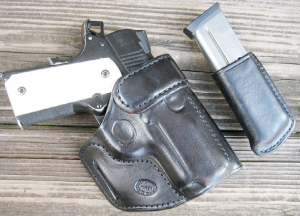
Springfield 9mm EMP in the Bruce Nelson-designed BN55 and #17 single magazine pouch as crafted by Sparks Holsters, Boise,Idaho
(miltsparks.com). While at the Sparks shop, I ordered a straight drop, black, BN55 and a matching EMP sized #17 single mag pouch, both to fit a 1½-inch belt. Like all other customers (and we know these guys), I was advised of a delivery date six months hence.
My BN55 rig arrived around Christmas time. It is a gorgeous yet plain looking holster that is stamped with Jim Wall’s maker’s mark. The holster’s fit to the EMP is perfect and it rides solidly behind the hip on my Galco Tiger Shark Holster Belt. The #17 mag pouch was a really tight fit for the EMP’s magazine but letting it sit for a while with a plastic-wrapped mag in place eventually loosened the mag pouch up.
We used this rig, carrying our EMP, for most of the winter. It was comfortable and easily concealable with our normal cold weather wardrobe. This season we plan to use the 55BN when shooting the EMP in a few IDPA matches. This holster is a connection to handgunning’s history. Bruce Nelson was a creative holster maker, and a lawman, and it’s good to finally have an example of his iconic BN55 to tote around.
Another timeless Bruce Nelson holster design is the Summer Special IWB holster. This holster has been copied by many makers over the years.
Some of the copies are quite good, while others are abominations. But the Galco Royal Guard is an IWB holster which is made from horsehide, features a reinforced mouth, and dual belt straps. It is a pretty good Summer Special clone. Galco recently updated the Royal Guard with the addition of a sweat guard, which is a really nice touch. We have used a bunch of IWB holsters over the last 35+ years, mostly for toting around Colt Commanders.
However, when we started carrying our Springfield EMP we originally cut off an old Gordon Davis Model 455 IWB rig to tote the EMP in but soon after acquired a Galco Royal Guard. The old Galco Royal Guard, and now the updated version, is my warm weather, EMP carry rig. Nicely boned and very comfortable, the horsehide Royal Guard should serve us long and well and is a tribute to one great holster maker’s vision of efficiency. If you are in the market for an IWB rig, try a Royal Guard from Galco (galcogunleather.com), we doubt you’ll be disappointed.

